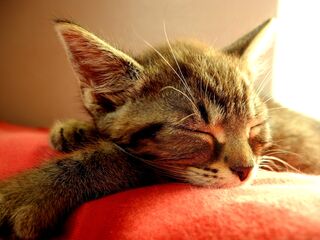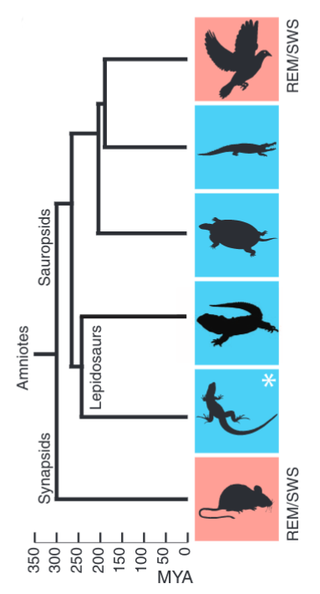Dreaming
Do Animals Have Dreams?
Evolutionary history and sensory ability shed light on animal dreams.
Posted July 22, 2022 Reviewed by Tyler Woods
Key points
- Dreams largely occur during REM sleep, but not all animals experience REM.
- Reptiles, birds and mammals all experience deep sleep, but most reptiles do not show REM.
- Periods of REM sleep are longest in mammals, allowing time for exteneded and more vivid dreams.
- Since dreams are fed by waking sensations, variations in sensory capabilities in different mammals likely shape the content of their dreams.

Anyone with a cat or dog can attest that they seem to experience dreams. As I write this, the sleeping spaniel next to me is making muffled barks, wagging her tail, breathing irregularly, and wiggling her front legs. For more evidence, see these adorable sleeping kittens.
We can’t read out the content of cat or dog dreams—nor can we read out their waking perceptions, even with the most advanced imaging and electrophysiology tools. But dreams, like all other features of our biology, are the product of Darwinian evolution. We can gain some insight into the dreams of other animals by examining which species do and do not dream, and we can ask how their sleep and dreams might relate to their senses. This approach can give hints as to what other animals dream about.
REM and Dreaming
In humans, we know that vivid dreams occur largely during rapid eye movement (REM) sleep, which happens at the end of a typical sleep cycle. REM sleep shows a clear electrical signature. Measured with electroencephalography (EEG) on the scalp, the collective movements of electrons into and out of billions of neurons generate large-scale electrical imbalances that fluctuate rapidly and at low amplitude. This means there are lots of small, fast changes in electrical potential across much of the brain's surface. The pattern is much like that measured when the animal is awake. So, even though the body is almost fully paralyzed during REM, the brain is active in ways similar to wakefulness.
The pattern of electrical activity during REM is quite similar across species. If an animal spends a fair amount of time in REM sleep, it is reasonable to assume they are experiencing dreams. How common is REM among animal species?
Sleep and Dreams in the Animal Kingdom
With few exceptions, all animals, including all invertebrates and vertebrates, experience periods of restfulness or inactivity. But only some lineages really sleep, meaning that they enter a substantially altered state of brain activity, triggered by internal factors, not just by a need to stop moving. Under this definition, sleep appears to occur in some invertebrates in the arthropod lineage, such as flies and crabs. But it is much more widespread in vertebrates. The first vertebrate deep sleepers probably lived more than 250 million years ago.
All amniotes (animals that develop in an amniotic sac) including all reptiles, birds, and mammals alive today experience deep sleep. This state is easily detected with EEG as an extended period of slowed electrical potentials called slow-wave sleep (SWS).
REM sleep, which follows long periods of SWS in a sleep cycle, seems to have evolved later. REM is found in all mammals and all birds, but evidence of REM in other reptilians has historically been mixed. However, recent EEG recordings in Australian dragons (a kind of lizard) found evidence for some degree of REM, suggesting that an ancestor shared by all reptiles, birds, and us, was the first to experience REM.
This early REM was probably limited in duration and intensity. In some reptile descendants living today, such as Australian dragons, it remains limited and may have been lost altogether in some reptile species.

But birds and mammals took the innovation of REM and ran with it. These groups strongly regulate their internal metabolism (they are endothermic, or "warm-blooded"), which seems to have allowed (or required) much more time to be spent in REM.
Mammals are Dreamers
Even though mammals and birds both spend considerable periods in REM sleep, REM seems to have become further enhanced in mammals. In birds, periods of REM last only a few seconds at a time, implying that the animal would be rapidly going into and out of dreams again and again.
Mammals alive today, on the other hand, have much longer bouts of REM sleep. This would allow more time for vivid dreams. In the animal kingdom, we and our furry mammal relatives are probably the most prolific dreamers.
From this evolutionary perspective, the possibility of dreaming is widespread in complex vertebrates, and its existence seems consequential. Whatever it is that is useful about dreams should extend to all mammals and, in more limited form, to birds as well.
The Content of Mammal Dreams
One implication of the universality of dreaming among mammals is that we can combine this knowledge with what we know about mammals' sensory experience during wakefulness. Whatever it feels like to “see,” "hear," “understand,” or “be aware of” something for a cat should be approximated in their dreams, albeit with some abstraction. At the same time, we know that mammals vary considerably in the relative power and precision of their sensory systems.
Mice, for example, rely very little on vision, and instead depend on touch (via whiskers), sound, and especially smell. Conversely, humans are highly visual, and we rely much less on smell. As I noted in a previous post, humans rarely dream about smells. If dreams largely draw on a species' "best" or most important sensory modalities, it stands to reason that a mouse's dream world is dominated by smells, sounds, and touch experiences. Cats, meanwhile, are highly visual mammals, like us (see my previous post on what the world looks like to a cat). So their dream world should favor visual experiences just as ours do.
An evolutionary perspective suggests that dreams serve a general function across species, and didn't just spring up for some human-specific reason. At the same time, the evolved characteristics of dreams in different species may relate to other aspects of a species' biology, especially how it senses the world. Our own dreams may even have special features that set them apart from those of other mammals, which could relate to cognitive capabilities, but the differences in our dreams compared to other mammal dreams are probably small.
Whatever the perceptual content of an animal's dreams, we should expect that the progression of experiences in all animals' dreams is just as chaotic (and, at times, repetitive) as it is in our own dreams. If this is the case, we can only wonder how they interpret these strange experiences upon waking. Maybe they are just as confused and fascinated as we are.
Copyright © 2022 Daniel Graham. Unauthorized reproduction of any content on this page is forbidden. For reprint requests, email reprints@internetinyourhead.com.
References
Ribeiro, S., & Nicolelis, M. A. (2007). The evolution of neural systems for sleep and dreaming. Evolution of Nervous Systems, Vol 3. Eds. J. Kaas and L. Krubitzer. Elsevier.
Shein-Idelson, M., Ondracek, J. M., Liaw, H. P., Reiter, S., & Laurent, G. (2016). Slow waves, sharp waves, ripples, and REM in sleeping dragons. Science, 352(6285), 590-595.




